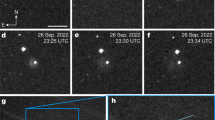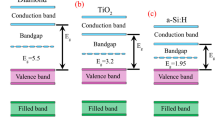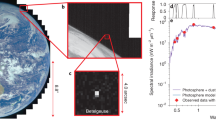Abstract
IT has been suggested1 that the interstellar extinction might be explained by assuming that the interstellar dust is composed of an appropriate size distribution of diamond particles. The imaginary part of the index of refraction of diamond increases sharply from near zero to about 1.0 at λ−1 = 5.0 µm−1, giving an albedo near unity in the visible and strong extinction in the ultraviolet, as required by recent observations.
This is a preview of subscription content, access via your institution
Access options
Subscribe to this journal
Receive 51 print issues and online access
$199.00 per year
only $3.90 per issue
Buy this article
- Purchase on SpringerLink
- Instant access to full article PDF
Prices may be subject to local taxes which are calculated during checkout
Similar content being viewed by others
References
Saslaw, W. C., and Gaustad, J. E., Nature, 221, 160 (1969).
Wickramasinghe, N. C., Nature, 222, 154 (1969).
Kimura, H., Publ. Astron. Soc. Japan, 14, 374 (1962).
Phillipp, H. R., and Taft, E. A., Phys. Rev., 127, 159 (1962).
Boggess, A., and Borgman, J., Astrophys. J., 140, 1636 (1964).
Stecher, T. P., Astrophys. J., 142, 1683 (1965).
Stecher, T. P., Astrophys. J. Lett., 157, L125 (1969).
Author information
Authors and Affiliations
Rights and permissions
About this article
Cite this article
LANDAU, R. Diamonds and the Interstellar Extinction Curve. Nature 226, 924 (1970). https://doi.org/10.1038/226924a0
Received:
Revised:
Issue date:
DOI: https://doi.org/10.1038/226924a0
This article is cited by
-
Interstellar diamonds in meteorites
Nature (1987)
-
The interrelationship between cosmic dust and the microwave background
Astrophysics and Space Science (1975)
-
Accretion and electrostatic interaction of interstellar dust grains; Interstellar grit
Astrophysics and Space Science (1973)



